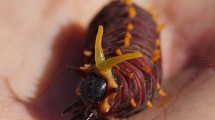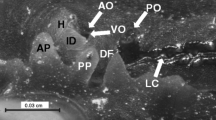Abstract
Effective defense is a common characteristic of insect societies. Indeed, the occurrence of specialized defenders, soldiers, has been the first step toward eusociality in several independent lineages, including termites. Among the multitude of defensive strategies used by termite soldiers, defense by chemicals plays a crucial role. It has evolved with complexity in advanced isopteran lineages, whose soldiers are equipped with a unique defensive organ, the frontal gland. Besides direct defense against predators, competitors, and pathogens, the chemicals emitted by soldiers from the frontal gland are used as signals of alarm. In this study, we investigated the chemical composition of the defensive secretion produced by soldiers of the termite Termitogeton planus (Isoptera: Rhinotermitidae), from West Papua, and the effects of this secretion on the behavior of termite groups. Detailed two-dimensional gas chromatography/mass spectrometry analyses of the soldier defensive secretion revealed the presence of four linear and nine monoterpene hydrocarbons. Soldier head extracts, as well as synthetic mixtures of the monoterpenes found in these extracts, elicited alarm behavior in both soldiers and pseudergates. Our results suggest that the alarm is not triggered by a single monoterpene from the defensive blend, but by a multi-component signal combining quantitatively major and minor compounds.






Similar content being viewed by others
References
Adams RP (2007) Identification of essential oil components by gas chromatography/mass spectrometry. Allured Publishing Corporation, USA
Bagnères A-G, Clément J-LA, Blum MS, Severson RF, Joulie C, Lange C (1990) Cuticular hydrocarbons and defensive compounds of Reticulitermes flavipes (Kollar) and R. santonensis (Feytaud): polymorphism and chemotaxonomy. J Chem Ecol 16:3213–3244
Barbosa JRC (2012) Sistemas de castas de Serritermes serrifer: (Isoptera: Serritermitidae). Universidade de Brasília, Dissertation
Bourguignon T, Roisin Y (2011) Revision of the termite family Rhinotermitidae (Isoptera) in New Guinea. ZooKeys 148:55–103
Bourguignon T, Šobotník J, Hanus R, Roisin Y (2009) Developmental pathways of Glossotermes oculatus (Isoptera, Serritermitidae): at the cross-roads of worker caste evolution in termites. Evol Dev 11:659–668
Bourguignon T, Šobotník J, Sillam-Dussès D, Jiroš P, Hanus R, Roisin Y, Miura T (2012) Developmental pathways of Psammotermes hybostoma (Isoptera: Rhinotermitidae): old pseudergates make up a new sterile caste. PLoS One 7:e44527
Chuah CH, Goh SH, Tho YP (1990) Chemical defense secretions of some species of Malaysian Rhinotermitidae (Isoptera, Rhinotermitidae). J Chem Ecol 16:685–692
Connétable S, Robert A, Bouffault F, Bordereau C (1999) Vibratory alarm signals in two sympatric higher termite species: Pseudacanthotermes spiniger and P. militaris (Termitidae, Macrotermitinae). J Insect Behav 12:329–342
Crespi BJ (1994) Three conditions for the evolution of eusociality: Are they sufficient? Insect Soc 41:395–400
Engel MS, Grimaldi DA, Krishna K (2009) Termites (Isoptera): their phylogeny, classification, and rise to ecological dominance. Am Mus Novit 3650:1–27
Gershenzon J, Dudareva N (2007) The function of terpene natural products in the natural world. Nat Chem Biol 3:408–414
Hertel H, Hanspach A, Plarre R (2011) Differences in alarm responses in drywood and subterranean termites (Isoptera: Kalotermitidae and Rhinotermitidae) to physical stimuli. J Insect Behav 24:106–115
Hunt JH, Richard FJ (2013) Intracolony vibroacoustic communication in social insects. Insect Soc 60:403–417
Inward DJG, Vogler AP, Eggleton P (2007) A comprehensive phylogenetic analysis of termites (Isoptera) illuminates key aspects of their evolutionary biology. Mol Phylogenet Evol 44:953–967
Kettler R, Leuthold RH (1995) Interspecific and intraspecific alarm response in the termite Macrotermes subhyalinus (Rambur). Insect Soc 42:145–156
Kirchner WH, Broecker I, Tautz J (1994) Vibrational alarm communication in the damp-wood termite Zootermopsis nevadensis. Physiol Entomol 19:187–190
Krasulová J, Hanus R, Kutalová K, Šobotník J, Sillam-Dussès D, Tichý M, Valterová I (2012) Chemistry and anatomy of the frontal gland in soldiers of the sand termite Psammotermes hybostoma (Rhinotermitidae). J Chem Ecol 38:557–565
Krishna K, Grimaldi DA, Krishna V, Engel MS (2013) Treatise on the Isoptera of the World. Bull Am Mus Nat Hist B377(1):1–200
Legendre F, Whiting MF, Bordereau C, Cancello EM, Evans TA, Grandcolas P (2008) The phylogeny of termites (Dictyoptera: Isoptera) based on mitochondrial and nuclear markers: Implications for the evolution of the worker and pseudergate castes, and foraging behaviors. Mol Phylogenet Evol 48:615–627
Legendre F, Whiting MF, Grandcolas P (2013) Phylogenetic analyses of termite post-embryonic sequences illuminate caste and developmental pathway evolution. Evol Dev 15:146–157
Parmentier D, Roisin Y (2003) Caste morphology and development in Termitogeton nr. planus (Insecta, Isoptera, Rhinotermitidae). J Morphol 255:69–79
Pasteels JM, Bordereau C (1998) Releaser pheromones in termites. In: Van der Meer RK, Breed MD, Espelie KE, Winston ML (eds) Pheromone communication in social insects: ants, wasps, bees and termites. Westview Press, Boulder, pp 193–215
Perdereau E, Dedeine F, Christidès JP, Bagnères AG (2010) Variations in worker cuticular hydrocarbons and soldier isoprenoid defensive secretions within and among introduced and native populations of the subterranean termite, Reticulitermes flavipes. J Chem Ecol 36:1189–1198
Piskorski R, Hanus R, Vašíčková S, Cvačka J, Šobotník J, Svatoš A, Valterová I (2007) Nitroalkenes and sesquiterpene hydrocarbons from the frontal gland of three Prorhinotermes termite species. J Chem Ecol 33:1787–1794
Prestwich GD (1982) From tetracycles to macrocycles: chemical diversity in the defense secretions of nasute termites. Tetrahedron 38:1911–1919
Quennedey A (1984) Morphology and ultrastructure of termite defense glands. In: Hermann HR (ed) Defensive mechanisms in social insects. Praeger, New York, Philadelphia, pp 151–200
Quennedey A, Deligne J (1975) L’arme frontale des soldats de termites. I. Rhinotermitidae. Insect Soc 22:243–267
Quintana A, Reinhard J, Faure R, Uva P, Bagnères AG, Massiot G, Clément J-LA (2003) Interspecific variation in terpenoid composition of defensive secretions of European Reticulitermes termites. J Chem Ecol 39:639–652
Reinhard J, Clément J-L (2002) Alarm reaction of European Reticulitermes termites to soldier head capsule volatiles (Isoptera, Rhinotermitidae). J Insect Behav 15:95–107
Reinhard J, Quintana A, Sreng L, Clément J-L (2003) Chemical signals inducing attraction and alarm in European Reticulitermes termites (Isoptera, Rhinotermitidae). Sociobiology 42:675–691
Röhrig A, Kirchner WH, Leuthold RH (1999) Vibrational alarm communication in the African fungus-growing termite genus Macrotermes (Isoptera, Termitidae). Insect Soc 46:71–77
Roisin Y, Everaerts C, Pasteels JM, Bonnard O (1990) Caste-dependent reactions to soldier defensive secretion and chiral alarm/recruitment pheromone in Nasutitermes princeps. J Chem Ecol 16:2865–2875
Šobotník J, Hanus R, Kalinová B, Piskorski R, Cvačka J, Bourguignon T, Roisin Y (2008) (E, E)-α-Farnesene, an alarm pheromone of the termite Prorhinotermes canalifrons. J Chem Ecol 34:478–486
Šobotník J, Jirošová A, Hanus R (2010) Chemical warfare in termites. J Insect Physiol 56:1012–1021
Stuart AM (1963) Studies on the communication of alarm in the termite Zootermopsis nevadensis (Hagen), Isoptera. Physiol Zool 36:85–96
Stuart AM (1988) Preliminary studies on the significance of head-banging movements in termites with special reference to Zootermopsis angusticollis (Hagen) (Isoptera: Hodotermitidae). Sociobiology 14:49–60
Tholl D (2006) Terpene synthases and the regulation, diversity and biological roles of terpene metabolism. Curr Opin Plant Biol 9:197–304
Tian L, Zhou X (2014) The soldiers in societies: defense, regulation, and evolution. Int J Biol Sci 10:296–308
Vrkoč J, Křeček J, Hrdý I (1978) Monoterpenic alarm pheromones in two Nasutitermes species. Acta Entomol Bohemoslov 75:1–8
Zhang SM, Mo JC, Teng L, Cheng ML, Cheng JA (2006) Inter-colonial variation in the compositions of the frontal gland secretion of Coptotermes formosanus (Isoptera: Rhinotermitidae). Sociobiology 47:553–561
Acknowledgments
Financial support was provided by the Czech Science Foundation (P506/10/1570) and by the Institute of Organic Chemistry and Biochemistry, Academy of Sciences of the Czech Republic, Prague (RVO: 61388963). We are grateful to collaborators Jan Šobotník and Thomas Bourguignon for help with the collection of T. planus and to Petr Jahoda for logistic support during the mission to West Papua. We thank Irena Valterová and two anonymous reviewers for comments on the previous version of the manuscript.
Author information
Authors and Affiliations
Corresponding author
Rights and permissions
About this article
Cite this article
Dolejšová, K., Krasulová, J., Kutalová, K. et al. Chemical alarm in the termite Termitogeton planus (Rhinotermitidae). J Chem Ecol 40, 1269–1276 (2014). https://doi.org/10.1007/s10886-014-0515-0
Received:
Revised:
Accepted:
Published:
Issue Date:
DOI: https://doi.org/10.1007/s10886-014-0515-0




